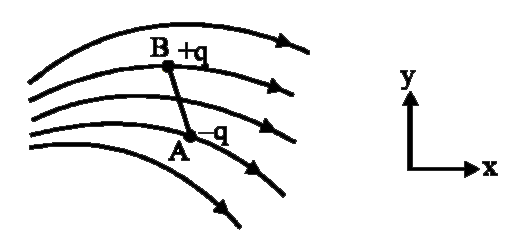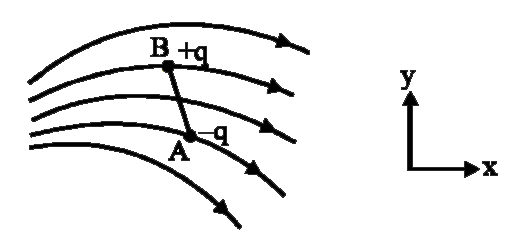An electric dipole is formed by two equal and opposite charges q with separation d. The charges have same mass m. It is kept in a uniform electric field E. If it is slightly rotated from its equilibrium orientation, then its angular frequency ω is:
√qE2md
√2qEmd
√qEmd
2√qEmd
The correct Answer is:B
Let dipole is rotated through an angle θ with the electric field. Forces acting on the dipole is as shown in the diagram.

Moment of inertia of dipole can be written as follows :
I=2×m(d/2)2=md2/2
⇒τ=Iα
⇒(qE)(dsinθ)=md22α⇒α=2qEmdsinθ
Here θ is small angle, ⇒α=2qEmdθ
Since torque is of restoring nature so we can use negative sign to write the above expressions as follows :
⇒α=−2qEmdθ
On comparing it with α=−ω2θ, we get
ω=√2qEmd
Topper's Solved these Questions
- BOOK - MODERN PUBLICATIONCHAPTER - ELECTRIC CHARGES AND FIELDS EXERCISE - COMPETITION FILE ( Objective Question (BC.MCQ))10videos
ELECTRIC CHARGES AND FIELDS
- BOOK - MODERN PUBLICATIONCHAPTER - ELECTRIC CHARGES AND FIELDS EXERCISE - COMPETITION FILE ( Objective Question (C.MCQ))19videos
ELECTRIC CHARGES AND FIELDS
- BOOK - MODERN PUBLICATIONCHAPTER - ELECTRIC CHARGES AND FIELDS EXERCISE - COMPETITION FILE ( Objective Question (BA.MCQ))3videos
ELECTRIC CHARGES AND FIELDS
- BOOK - MODERN PUBLICATIONCHAPTER - DUAL NATURE OF RADIATION AND MATTER EXERCISE - CHAPTER PRACTICE TEST15videos
DUAL NATURE OF RADIATION AND MATTER
- BOOK - MODERN PUBLICATIONCHAPTER - ELECTROMAGNETIC INDUCTIONEXERCISE - CHAPTER PRACTICE TEST FOR BOARD EXAMINATION14videos
ELECTROMAGNETIC INDUCTION
Similar Questions
An electric dipole (AB) consisting of two particles of equal and opposite charge and same mass is released in an electric field. In the figure field lines are without considering effect of field of dipole.

Angular acceleration of the dipole, immediately after it is releasedView SolutionAn electric dipole (AB) consisting of two particles of equal and opposite charge and same mass is released in an electric field. In the figure field lines are without considering effect of field of dipole.

The centre of mass of the dipoleView Solution
Knowledge Check
- Question 1 - Select One
An electron having charge 'e' and mass 'm' is moving a uniform electric field E. Its acceleration will be
Ae2mBE2emCeEmDmEe - Question 2 - Select One
An electric dipole has the magnitude of its charge as q and its dipole moment is p. It is placed in a uniform electric field E. If its dipole moment is along the direction of the field, the force on it and its potential energy are respectively
A2qE and minimum.BqЕ and pE.Czero and minimum.DqE and maximum. - Question 3 - Select One
An electric dipole has the magnitude of its charge as q and its dipole moment is p. It is placed in a uniform electric field E. If its dipole moment is along the direction of the field, the force on it and its potential energy are respectively
A2q.E and minimumBq.E and p.ECZero and minimumDq.E and maximum
A protons of mass m charge 2 e is released from rest in a uniform electric field of strength E .The time taken by it to travel a distance d in the field is..
View SolutionAn electric dipole is situated in an electric field of uniform intensity E whose dipole moment is p and moment of inertia is I. If the dipole is displaced slightly from the equilibrium position, then the angular frequency of its oscilliations is
View SolutionAn electric dipole is situated in an electric field of uniform intensity E whose dipole moment is p and moment of inertia E whose dipole moment is p and moment of inertia is I. If the dipole is displaced slightly from the equilibrium position, then the angular frequency of its oscillations is :
View SolutionAn electric dipole is situated in an electric field of uniform intensity E whose dipole moment is p and moment of inertia E whose dipole moment is p and moment of inertia is I. If the dipole is displaced slightly from the equilibrium position, then the angular frequency of its oscillations is :
View SolutionIf a simple pendulum has charge q and is oscillating in a uniform electric field E in the direction of acceleration due to gravity, then its frequency of oscillations
View Solution

